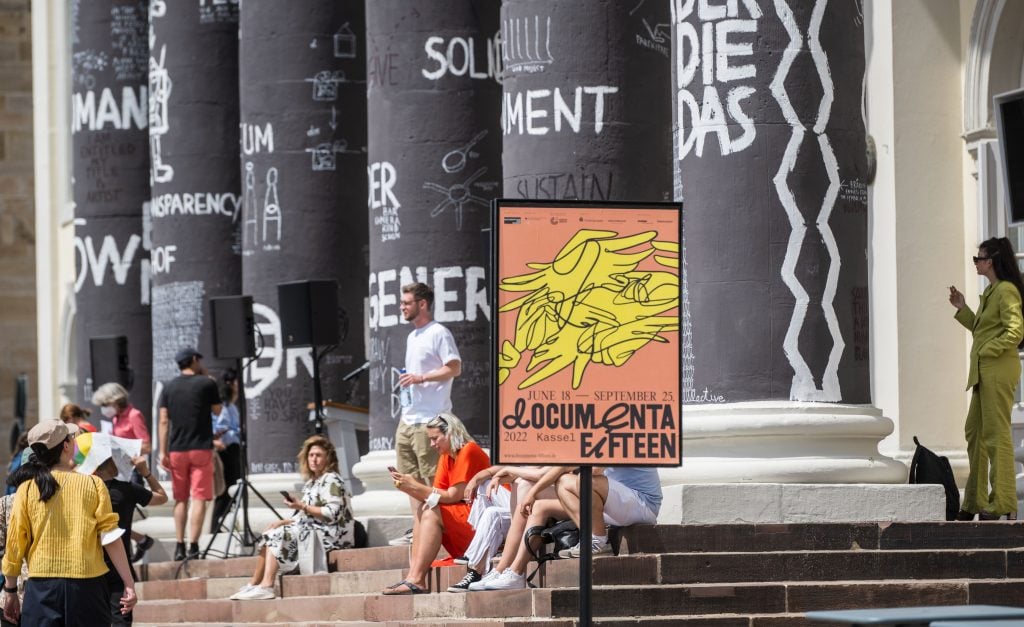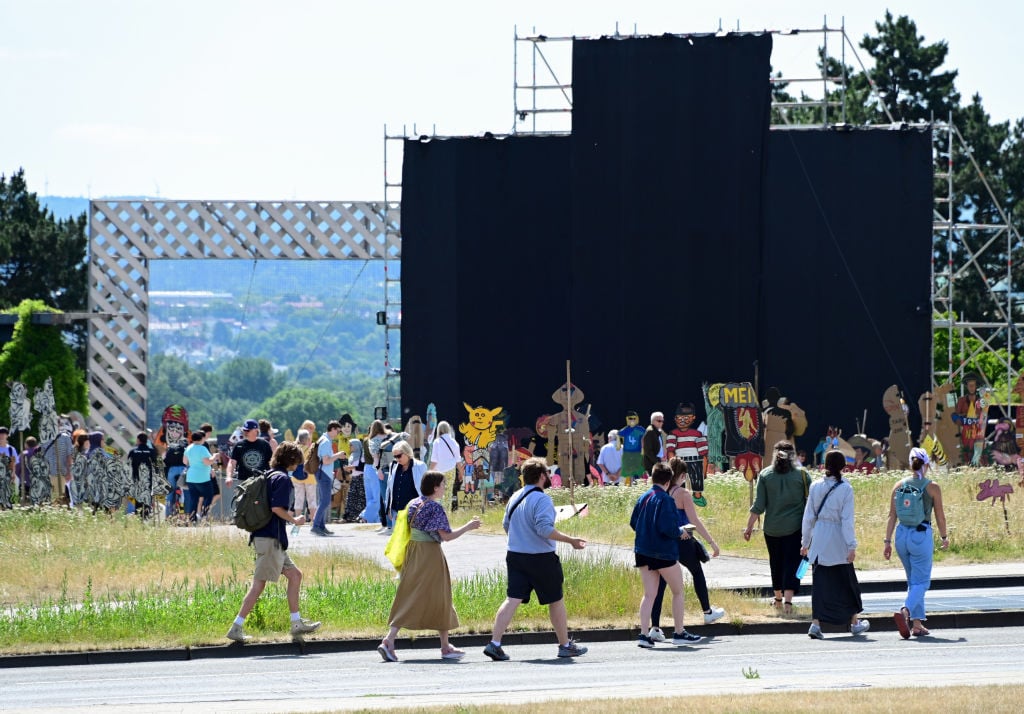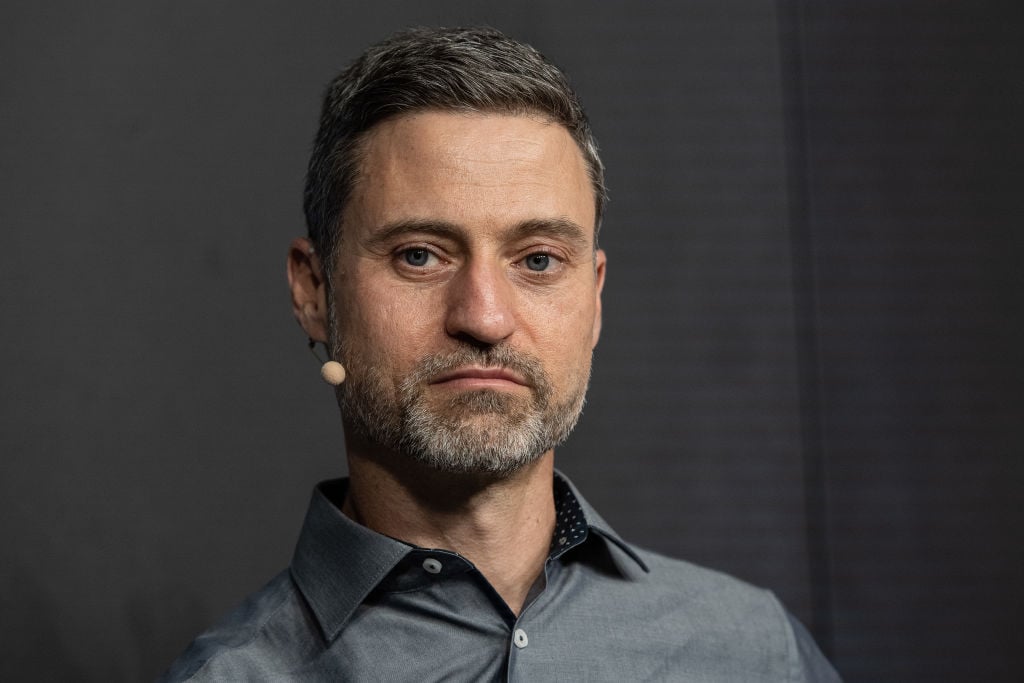Politics
Documenta, Battered by Scandals, Gets Hit With Yet Another Allegation of Antisemitic Imagery in the Show
The images by Burhan Karkoutly are in a pamphlet shown by the Archives of Women’s Struggles in Algeria.

The images by Burhan Karkoutly are in a pamphlet shown by the Archives of Women’s Struggles in Algeria.

Kate Brown

Another work depicting Jews with stereotypical anti-Semitic tropes has emerged at Documenta, just over a month after the 15th edition of the show opened and just weeks after a scandal emerged around anti-semitic imagery in a work by Indonesian collective Taring Padi.
Illustrations made in the 1980s by Syrian artist Burhan Karkoutly and on view at the Museum Fredericianum, one of the main locations of the citywide quinquennial, drew the attention of a visitor three weeks ago. Inside a facsimile of a 1988 brochure about the Palestinian liberation movement, created in Algeria and called Presence des Femmes, are drawings by Karkoutly which depict Israeli soldiers as robots, with Stars of David on their helmets.
Another image shows a woman kicking an Israeli soldier, who has a hooked nose and a star of David on his hat, in the groin. The brochure was included among archival reproductions in the exhibit by the Archives of Women’s Struggles in Algeria that chronicle the country’s post-independence era. The collective is one of the official participants in the giant exhibition, which runs until September 25 and is curated by the Indonesian collective Ruangrupa.
…gibt es zwar eine klare Bezugnahme auf den israelisch-palästinensischen Konflikt,aber keine Bebilderung von Juden ›als solchen‹.“
(https://t.co/8yMia2Dk4T)„Als solchen“
Shame on these people. Ich habe keine Worte. Man will einfach nur noch verschwinden. Und wütend weinen. pic.twitter.com/obtv1HeQpA
— Igor Levit (@igorpianist) July 27, 2022
Documenta’s shareholders, which are the city of Kassel and the state of Hesse, sent out a statement on Thursday, July 28, saying that they learned of the brochure only Tuesday evening this week via social media. In their statement, the shareholders urged the artistic team to remove the drawings until they can be “appropriately contextualized.” They also said that the situation shows “how urgently external expertise is needed.”
In a comment sent to Artnet News, scholars from the Archives of Women’s Struggles in Algeria explained that Présence de femmes journal was created by a collective of Algerian academics starting in the 1980s, and that this particular issue from 1988 had a special focus on Palestine. It dates to the year of the proclamation of the Palestinian State by the Palestine Liberation Organization and Yasser Arafat while in exile in Algiers, Algeria.
“This issue was in solidarity by the Algerian women with the Palestinian people, in denouncing the crimes committed by the Israeli State,” wrote the scholars in their statement, which was shared by Documenta. “We would like this document, like many other texts or artworks in the world, to be placed in its historical and political context. It is a document of the history of contemporary Algeria, produced within the framework of the struggles of Algerian women who are engaged in a struggle for equality against all forms of gender discrimination but also against all the oppression of peoples including those suffered by the Palestinians.”
The scholars added that Algiers was historically “a well known refuge for many liberation movements in the 60s and 70s, such as the South African liberation movement and the Black Panthers.”
In a joint statement shared on E-flux on July 27, Documenta 15’s artist and curators said that they “do not trust” the supervisory board of the exhibition. They said that the archives from the Archives of Women’s Struggles in Algeria) collective were removed from the exhibition without the knowledge or consent of the artists in early July. “We refuse the supervisory board’s recommendation to ‘enter a process of consultation with scholars from the fields of contemporary antisemitism,’ the authors wrote. “This environment of intimidation, suspicion, and censorship is untenable and some of the collectives in the exhibition have been experiencing it for far too long.”
Lesenswert: #Documenta sieht kein Problem – Zufallsfund offenbart neuen #Antisemitismus-Skandal auf der #documenta15.#Kunst #Kultur
via @welt https://t.co/aDnoticyUV— Recherche-& Informationsstelle Antisemitismus RIAS (@Report_Antisem) July 28, 2022
“This document is important for our project because it traces the history of the struggles of Algerian women in an international context and testifies to the diversity, transnationality and intersectionality of Algerian women’s grassroot political commitments beyond Algeria,” they added.
Documenta’s management team said they were made aware of the imagery in the brochure by a visitor to the exhibition three weeks ago, at which time a “legal assessment” was conducted by external parties. The work was then temporarily removed from view.
Documenta explained the process in its statement: “While there is a clear reference to the Israeli-Palestinian conflict, there is no imagery of Jews ‘as such.’ The Star of David, while clearly a Jewish symbol, here identifies the Israeli military as part of the state flag,” the statement reads. “The child with his hands behind his back next to the woman kicking the soldier apparently refers to a well-known Palestinian cartoon as a critique of treatment by the military.”
The work was found to be of “no criminal relevance” and was therefore reinstalled in the exhibition. At the time, Documenta general director Sabine Schormann was helming the organization. (She was removed by mutual agreement at the beginning of July. An interim director, Alexander Fahrenholtz, replaced her.)

Art lovers look at the large painting People’s Justice (2002) by the Indonesian collective Taring Padi, covered with black cloth, on Friedrichsplatz. Photo by Uwe Zucchi/picture alliance via Getty Images.
Documenta’s team said that “after reconsideration” further contextualization of the work will now be given, even as they emphasized that there will be no further screenings of other works in the show for anti-Semitic motifs. The new interim director Fahrenholtz also recently emphasized this, saying that it was ultimately up to the curators and the artistic team whether any contentious works remain on view or not, stressing their curatorial freedom.
In a statement sent to Artnet News, Germany’s minister of culture Claudia Roth agreed with the shareholders’ requests.
“It is good and right that the shareholders of Documenta have now asked the artistic direction to remove these drawings from the exhibition. I can only agree with this,” said Roth. “The way these drawings were handled before Mr. Farenholtz took office shows once again how important and necessary it is to have an external body of experts to analyze and classify the works shown at Documenta in terms of possible anti-Semitic imagery. This expertise should then also be taken very seriously by those responsible for Documenta.”
A scandal about possible antisemitism within Documenta 15’s team and participants emerged in January when a anonymous blog post from the Alliance Against Antisemitism Kassel website accused a few members of Ruangrupa, as well as some of the participating artists, of supporting the pro-Palestinian Boycott, Divest, and Sanctions movement.

Meron Mendel, director of the Anne Frank Education Center, speaks on the topic of “Anti-Semitism in Art” at a panel organized by the Anne Frank Education Center and the supporting organization documenta gGmbH. Photo: Swen Pförtner/dpa via Getty Images.
Just after the show opened on June 18, visitors to the show identified antisemitic imagery in Taring Padi’s work, People’s Justice. The work, which was collectively made in 2002 and was a reflection on the brutality of the Suharto regime in Indonesia and its collaborators, shows, among its many characters, a man with a pig’s nose and a Star of David and a helmet that reads “Mossad.” There is another man depicted with temple curls, bloodshot eyes, and a hat that has SS Nazi insignia on it. People’s Justice was covered up before being removed amid apologies from both the artistic directors and the collective.
Meron Mendel, director of the Anne Frank Institute, was invited to advise Documenta on its handling of antisemitism and he convened an emergency panel at the end of June to discuss the wider issue of antisemitism in art. The exhibition in Kassel, which is one of the most prominent recurring exhibitions of international art in the world, began to face calls for its closure and defunding by some German political parties.
In late June, one of the most prominent artists in the show, Hito Steyerl, pulled out of the exhibition, citing a “refusal to facilitate a sustained and structurally anchored inclusive debate around the exhibition, as well as the virtual refusal to accept mediation.” Mendel also resigned from his post. In early July, Sabine Schormann’s position was suddenly terminated by mutual agreement with Documenta’s shareholders.
Ruangrupa’s exhibition has brought together more than 1,500 artists working in collectives from around the world but mostly from the Global South. It runs until September 25.
Note: This article was updated on July 29 to include a statement from the artists, curators, and artistic team that is published on E-flux.